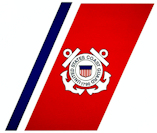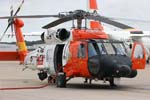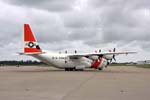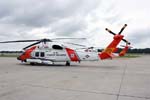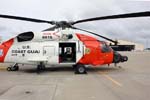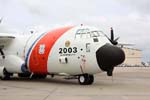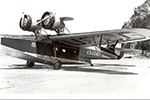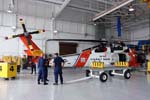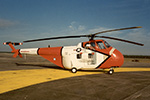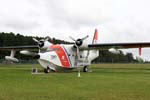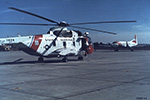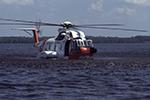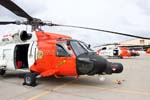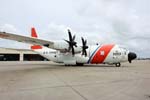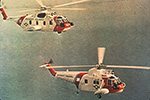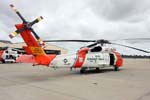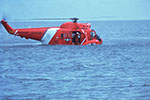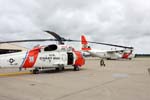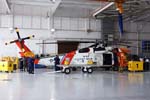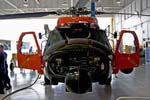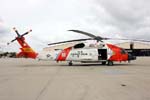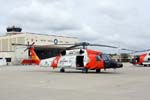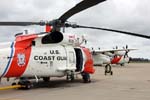The Air Station itself is home to more than 400 personnel (a number that is constantly increasing), six HC-130J Hercules aircraft and five MH-60J Jayhawk helicopters. Generally they strive to keep at least two H-60s and two C-130s mission ready, one being the primary SAR aircraft, the other being the backup, although there are typically more ready to go than are unavailable. It also just so happens to be the only air station to have the new HC-130J on strength and is the birthplace of the first MH-60T which has since moved to CGAS Mobile, Alabama. Without the backup of the Support Centre, the personnel trained via the ATTC and depot-level maintenance provided by the AR&SC, these aircraft would be little more than expensive paperweights but on the other hand, it is these aircraft (plus the boats, of course), that are used to save lives and though that is one of the primary job descriptions of a Coastie, that’s not all they do. In fact, you may be surprised by how much they actually do and where they do it. |
|
|
What a large number of people don’t know is that the US Coast Guard isn’t like, for instance, the UK’s HM Coast Guard, as it is a fully fledged branch of the US military and has been part of every US conflict since the late 1700s. It may be the smallest of the five branches but military it still is and by itself would arguably be quite a match for the naval forces of many a country the world over. The reason for the Coast Guard’s being isn’t solely to come to the aid of swimmers, sailors or anyone else in need of help out at sea but it is to protect the interests of the United States in any maritime region in which those interests are under threat – be that at home in US territorial waters or in far flung regions of the world. Those interests mean that the USCG are involved in such activities as counter narcotics operations, fishery protection in the world’s largest Exclusive Economic Zone (2,250,000mi2), monitoring icebergs and their movements, and interception of illegal immigrants – all of which are missions flown out of Elizabeth City. The NSFCC manages and supports the Atlantic Strike Team (AST), Gulf Strike Team (GST) and Pacific Strike Team (PST), in addition to the Public Information Assist Team (PIAT) – and whilst these, PIAT excepted, sound like some kind of SEAL-like armed-to-the-teeth Counter Terrorist outfits, they’re not. They provide appropriate assets to federal agencies in the response to hazardous pollutant incidents such as oil and chemical spills. Furthermore, although it is a military force under the control of the Department of Homeland Security, the USCG is not bound by the Posse Comitatus Act and is therefore allowed to enforce US law, with force if needs be, on US territory and its citizens. |
In a location just south of Elizabeth City on the west bank of the Pasquotank River in Pasquotank County, North Carolina, is where the US Coast Guard first began its association with the Inner Banks region in 1940 when 300 acres of an old farm became home to a new Coast Guard installation. Initially it was home to about 60 personnel with Hall PH-2 patrol seaplanes, Fairchild J2K light transports and Grumman J2F-1 Duck amphibious utility biplanes; aircraft types which were later joined by Consolidated N4Y trainers, Grumman JRF-2 Goose light amphibious transports and N.A.F N3N-3 Canary biplane trainers. The base spent the first five years of its life under US Navy operational control. During this period, the USN moved more than 8,000 personnel and 100+ aircraft into the North Carolina base. USN assets not withstanding, the aircraft had, thus far, all been unarmed and unable to do much more than shout at German U-Boats although a machine-gun toting Widgeon is credited with a sole U-Boat kill. Two Grumman J2F-5 Ducks already on strength with Elizabeth City were provided with rudimentary armament in January of 1942, making them the first “proper” armed aircraft, although it wasn’t until December 1943 that aircraft more suitable to the anti-submarine mission were procured with the arrival of five Martin PBM-3S Mariner patrol bomber flying boats. |
|
|
Following the war, the station expanded with the building of the Aircraft Repair & Supply Base (AR&SB) in 1947, a facility which all USCG aircraft went through, and the incorporation of the Bermuda and Argentia air stations in the 1960s. Further expansion came with the ATTC, basically boot camp for enlisted aviation ratings, which was constructed during the 1970s. During its sixty-eight year existence, the station has seen a vast number of types come and go which included the likes of the Grumman HU-16E Albatross and Sikorsky HH-52A Seaguard, retired examples of which are impressively displayed alongside a boat just outside the main gate and are a fitting tribute to the sterling service provided by the two types. The HH-52, the first amphibious helicopter in the USCG, also happens to hold the record for the number of people saved by a helicopter with more than 15,000. In addition to the HU-16E and HH-52A, other types that have, at some point, called the North Carolina base “home”, irrespective of the fact that the base has seen examples of every type of aviation asset go through at some point, have included the Sikorsky HNS-1 Hoverfly, Vought OSU2 Kingfisher, Curtiss R5C-1 Commando, Sikorsky HO-3S Dragonfly, Convair C-131 Samaritan, Consolidated PBY-5A Catalina, Piasecki HRP-1 Flying Banana, Sikorsky HO4S-2G & HO4S-3G (aka HH-19G) Chickasaw, Gulfstream VC-4, Douglas R5D-3 Skymaster and the Boeing PB-1G Flying Fortress. By the 1960s, the long range R5D-3s and PB-1Gs had been replaced by the Lockheed HC-130B Hercules which ushered in the turboprop era. |
The HC-130 is still at the tip of Elizabeth City’s long range spear although the older models have since given way for the absolutely brand new HC-130J. The twenty-two HC-130s form the Long Range Surveillance (LRS) platform and operate in areas where the shorter-legged Medium Range Surveillance (MRS) aircraft, the HC-144A Ocean Sentry, cannot. One such role the HC-130s perform is the International Ice Patrol mission - these IIP missions, which ramp up operations between January and August, last anything up to seven hours covering the best part of 30,000 square miles around the primary shipping routes between the US and Europe. They must be doing something right as there hasn’t been a single reported loss of life caused by collisions with ice since the patrols started all the way back in 1913, just one year after the loss of the Titanic. The C-130s can also aid people in urgent need of help by dropping life rafts and survival kits; both of which could prove to be of invaluable assistance until they’re plucked from the ravages of the North Atlantic by helicopter or boat. However, given the HC-130Js can, do and will operate as far out as Greenland, The Azores and in the Caribbean, that help could be a long time coming if there isn’t any shipping nearby. |
|
Able to cause a bit of confusion in local air traffic control thanks to the greater performance, the $70M HC-130Js are popular with the crews that fly them and also bring additional features to the table that the older H models didn’t provide such as a range of about 5,500nm compared to about 4,100nm and an endurance of about 21 hours compared to 14. As a comparison, the HC-144A has a range of ‘just’ 1,500nm and an endurance of about 9 hours. Once “missionised”, the HC-130J is fitted out with a belly-mounted EL/M-2022(V)3 multi-mode radar and nose mounted Star SAFIRE III FLIR pod that ensures that, for instance, a drug runner can’t run and certainly can’t hide or a vessel in distress can be found in inclement weather. Currently not yet fitted fleet-wide, all HC-130Js will eventually get the surveillance equipment and additional wing tanks, the latter of which will improve the already impressive long range surveillance capabilities even further. Just imagine, for a moment, a go fast (think high speed powerboat and you’re just about spot on) is using the cover of darkness and a bit of mist to smuggle a quantity of drugs into the US. With the equipment on the HC-130J, the crew are able to find and follow the boat from distances of more than 200 nautical miles away... the smugglers wouldn’t even know they’re being watched, let alone followed. The system on the HC-130J is essentially identical to that on the HC-144A and the 90% commonality in C4ISR (Command, Control, Communications, Computers, Intelligence, Surveillance, and Reconnaissance) systems between the two platforms, means an HC-144A qualified operator can transition to the HC-130J in a very short period of time (and vice versa). |
The USCG C-130 fleet, be that the six new HC-130J or the sixteen older HC-130Hs are also extensively used as good old fashioned cargo haulers – and in fact, the fleet is one of the world’s most used C-130 fleets. Whilst both types are roughly the same in terms of what and how much they can carry, the HC-130J requires less crew and introduces a new in-floor system where rollers can be rapidly switched over to tie-down points without the need for a spare afternoon and a toolkit meaning greater efficiency. They could, for instance, carry a HH-65C (or MH-60J following even more work with the toolkit) out to wherever it may be needed and once there, spend a few minutes turning the cargo rails over and then load up with pallets for the flight home. This is in addition to, on both flights, having the ability to use the surveillance equipment with no effect on the ability to complete the mission thanks to fact that the operators sitting behind a number of screens up on the flightdeck behind the navigator. If you were to have a brief look inside the hold of a missionised HC-130J, it would look like any other C-130J with the only difference being the addition of a palletised rack or two of survival gear. |
|
|
Search and rescue wise, which is the role typically associated with the USCG, Elizabeth City’s MH-60J Jayhawk Medium Range Recovery (MRR) helicopters average a total of about 360 missions per year; which is roughly one mission each and every day or night, come rain, shine or high winds. The call for help can come through either 911 or VHF, the difference in response between the two is only a matter of minutes as 911 operators generally recognize the maritime nature of the emergency and will patch the call directly to a USCG Command Center; at this point the Command Center selects the appropriate resource and that’s when a station such as Elizabeth City gets the call. Using VHF shaves a few minutes off this response time but the end result is the same. Contrary to what is shown in The Guardian, where the command center looks more like the CDC of an aircraft carrier, Elizabeth City’s command/control room is little more than an office, complete with wall mounted maps of the region. Enlisted personnel man the phone/radio during the day shift and an officer takes over for the night shift. |
Replacing the much larger HH-3F Pelican, the T700-powered MH-60Js are more powerful and faster yet can head out 300 miles at about 140kts, spend 30 minutes in the hover to winch six people aboard then head back to where they took off from and still have a little gas to spare although, unlike the HH-3F, they can forget the concept of landing on the water as whilst a Pelican can float, a Jayhawk will undoubtedly sink. It has been known for an Elizabeth City Jayhawk to have made it all the way to Bermuda, almost 700 miles away, on one tank of gas although it was almost running on fumes and the crew were keeping a very close eye on the needle – and unlike it’s HH-60G Pavehawk cousin, the Jayhawks are not fitted for in-flight refuelling (and if they were, the HC-130Js don’t have the ability to offload fuel). They can, however, re-fuel while flying alongside ships in an operation known as HIFR or Helicopter In-Flight Refueling where a fuel pipe is passed up to the helicopter. |
|
|
Another role Jayhawk crews practice is airborne use of force – a widely accepted tool of law enforcement whereby, following a number of warning shots which quite clearly state the intentions and could be considered a reasonably polite way of asking someone to stop the go fast, a highly trained, extremely competent sniper aboard a Jayhawk can put a 50 Cal round straight through the engine block. When an engine block has more holes than the manufacturer originally intended they tend to stop quite quickly and, propulsion wise, it leaves the boat relying on oars… you may well have seen a reasonable portrayal of airborne use of force in another Hollywood movie to feature the US Coast Guard, Bad Boys 2. |
Not many years from now will see the MH-60Js make way for the upgraded MH-60Ts – this variant is, bluntly speaking, an upgraded MH-60J with an additional, almost gunship-like role. In addition to being upgraded with new avionics and a glass cockpit, the “Airborne Use of Force” package provides the Jayhawk with a more than capable bite in the form of a derivative of the M14 rifle, a 50 Cal rifle or M240 7.62mm machine gun and also adds armour to the mix to help protect the crew. The MH-60T is also able to take a 6-man Counter Terrorist team 200nm offshore (or off the back of a suitable Cutter), deploy them by means of a fast roping system and then provide a degree of armed cover whilst the team go about their business; without the CT team, the MH-60T could also be employed against maritime targets up to 400nm from an Air Station or Cutter. What this means is eventually all Jayhawks will be able to do what the Jacksonville-based HH-65Cs of HITRON can do right now – get up close and personal with, then stop, fast moving drug runners that fight back. With eight MH-60Ts being converted every year at Elizabeth City’s AR&SC, all forty-two MH-60Js will be converted to the Tango standard by 2013. |
In the last sixty years, Elizabeth City SAR assets alone have helped more than 10,000 people go home to their families and when you meet some of the people involved in this most selfless of tasks, it’s not hard to understand how and why. The Coast Guard used to maintain “you have to go out; you don’t have to come back” but this has changed somewhat as it would be beyond the realms of stupidity to risk a number of highly trained Coasties (plus the expensive equipment) on the rescue of, say, a single person in difficulty. Don’t get me wrong, these guys won’t look out of a window, see it’s a bit windy (constant wind isn’t much of an issue but gusts can be problematic) and not bother but if they get out to the scene and their lives are on the line, there could well be a tough decision to make… could you lay your life down so a stranger can live? These guys can and do. The Coast Guard flightcrew and maintenance personnel are clearly extremely capable, well trained and talented individuals without whom the helicopter is going nowhere. But there is one breed of Coastie a bit different to the rest although they are as down to earth and humble as everybody else – the rescue swimmer (incidentally, the first ever rescue swimmers were declared operational at Elizabeth City in March 1985). Once the Jayhawk gets to the scene, the sea could be so rough you could get seasick on the Queen Mary 2 yet there’s a high probability the rescue swimmers will jump in. In case you were wondering, yes, there are female rescue swimmers although there aren’t any currently stationed at Elizabeth City. |
Going back to the movie “The Guardian” for a moment, we have it on very good authority that it is a reasonably accurate portrayal of the rescue swimmer and their training – yes, it has a couple of ‘enhanced for Hollywood’ moments but most true to life films do. What the film doesn’t quite show is how long the tough selection / training process goes on for and just how arduous it is. A Coast Guard rescue swimmer goes through eighteen tough weeks of selection that is tougher than all but the super-elite USAF Pararescue Jumper (PJ) programme – if someone chooses to quit, that’s it. Done. No coming back. No second chances. If they have to quit due to injury, they may get a second shot. It’s clearly not a case of showing up with a pair of swimming trunks, proclaiming to be a good swimmer and taking it from there as the rescue jumpers are a tough, fit lot and it’s certainly reassuring to know people like this take pride in their work and are about if people need their help… and unlike the film, they won’t leave one of their own out there. When they’re not busy being rescue swimmers, they’re also responsible for ensuring the life support equipment for Hercules and Jayhawk flight crews are in full working order so it’s not just a case of sitting around waiting for their next opportunity to throw themselves out of a fully functioning helicopter. |
|
|
As fully trained EMTs, once on scene they will assess and categorise the patients and, if needs be, provide medical assistance and aid the flight crew in their recovery. In typical rescues, this can be achieved by either using the basket or the strop – in the first instance, the patient is literally placed in a basket and winched to safety where as the strop is a simpler solution which is little more than a padded loop that is placed round a patient’s torso and is secured under the armpits. Obviously the means of rescue will depend on the particular injuries and, if the situation so requires, the patient can be immobilised on a spinal board before being winched to safety. Depending on what equipment is being carried at the time, there is a reasonable amount of room in the Jayhawk cabin but at least one rescue swimmer is noted for shoe-horning twenty people into it. Not two. Not ten. Twenty! That’s a lot of people to get into what is basically a Blackhawk and is considered a bit of a record. Looking at it a different way, would you put up with slightly cramped conditions on your way to safety and improved medical help or would you rather bob about in rough seas until they came back for you? Hardly a tough call that one! |
Although it’s easy, well, probably easy, to simply lay back and not worry about preparation with the excuse of “it’s OK, the Coast Guard will get me”, it’s preparation (or more specifically a lack of it), that means the Jayhawk and Hercules crews have to turn out in all sorts of weather. One mission described to us was text book stuff – the guys on a capsized boat were all in properly fitting immersion suits and sat waiting for help, with their supplies, radios and beacons, in their life raft. Another one, well, let’s just say quite the opposite... it wasn’t just a case of not having correctly fitting suits (for instance, a suit that’s too big isn’t much help and can dramatically decrease your chance of survival especially if it fills with water); it was more of a case of not having any suits. It does make you wonder what goes through some people’s minds when they venture out on the open ocean equipped for little more than a paddle at the beach or a cruise round a boating lake. |
|
It’s very reassuring to know the people of the Coast Guard are ready, willing and able to step up and do whatever it takes so that others may live. Semper Paratus. |

